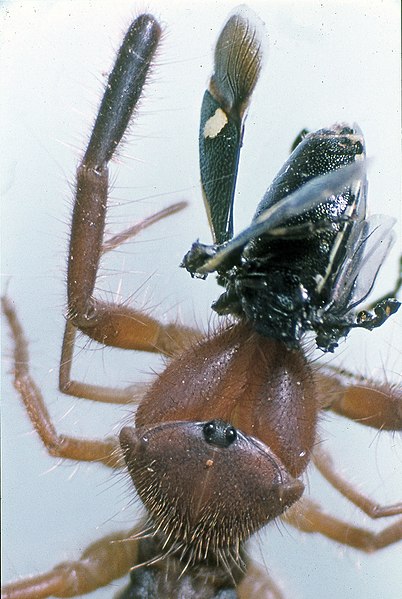 As a bug-hunting child, I was once startled to come upon a housefly that appeared to be walking on its hind legs. Closer inspection revealed that the unfortunate insect was being carried in a head-up position by a Jumping Spider. I was aware that a variety of these brilliantly-colored little beasts inhabited my Bronx neighborhood, and became interested in how they managed to capture such elusive prey without a web. I began reading and collecting, and was soon fascinated by their keen eyesight and cat-like stalking techniques. They would follow my finger, leap on a feathers pulled by a string, and even display to a mirrors.
As a bug-hunting child, I was once startled to come upon a housefly that appeared to be walking on its hind legs. Closer inspection revealed that the unfortunate insect was being carried in a head-up position by a Jumping Spider. I was aware that a variety of these brilliantly-colored little beasts inhabited my Bronx neighborhood, and became interested in how they managed to capture such elusive prey without a web. I began reading and collecting, and was soon fascinated by their keen eyesight and cat-like stalking techniques. They would follow my finger, leap on a feathers pulled by a string, and even display to a mirrors.
I’ve recently learned that biologists are showing videos to Jumping Spiders in an attempt to learn more about their remarkable eyes (which allow for forward, backward, an sideways vision simultaneously), and that a new ant-mimicking Jumping Spider with enormous fangs has turned up in Borneo. I’ll highlight this new information below, and review their natural history and captive care.
A 360 Degree Field of Vision
Animals that are on the menus of other creatures generally have eyes set well back and to the sides of their heads. This arrangement gives mice, deer and others a wide field of vision, with the only bind spots being well to their rear. Predators, such as foxes and hawks, usually have forward-facing eyes, to allow for accurate focusing on prey. Read More »
 That Reptile Blog – Reptile, Amphibian and Exotic Pet Care and Information
That Reptile Blog – Reptile, Amphibian and Exotic Pet Care and Information




